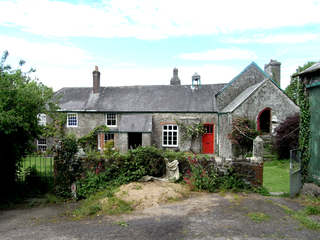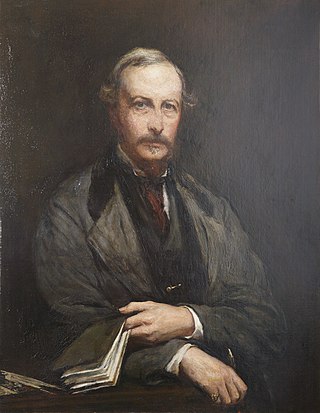
Beaford is a village and civil parish in the Torridge district of Devon, England. The village is about five miles south-east of Great Torrington, on the A3124 road towards Exeter. According to the 2001 census the parish had a population of 393, compared to 428 in 1901. The western boundary of the parish is formed by the River Torridge and it is surrounded, clockwise from the north, by the parishes of St Giles in the Wood, Roborough, Ashreigney, Dolton, Merton and Little Torrington.

Sir Hugh Acland, 5th Baronet was an English Member of Parliament, from a family of Devonshire gentry. He obtained a confirmation of the family baronetcy in 1678, and served as a Member of Parliament for two boroughs in Devon in 1679 and from 1685 to 1687. Never very active in national politics, he was one of the many Tories estranged by James II's pro-Catholicism, but remained a Tory after the Glorious Revolution. He continued to hold local office in Devon off and on until his death in 1714, when he was succeeded by his grandson.

Goodleigh is a village, civil parish and former manor in North Devon, England. The village lies about 2+1⁄2 miles (4 km) north-east of the historic centre of Barnstaple. Apart from one adjunct at the south, it is generally a linear settlement.

Sir John Acland, 1st Baronet of Acland in the parish of Landkey and of Columb John in Devon, England, was a Royalist commander in the Civil War, during the early part of which he maintained a garrison for the king on his estate of Columb John. He was created a baronet in 1644 for his support, but the letters patent were lost or never finalised and the dignity was not confirmed until 1677/8, long after his death. He compounded with Parliament for his estate in 1646 and died the following year.

Sir Thomas Dyke Acland, 7th Baronet of Killerton in Devon and Petherton Park in Somerset, was Member of Parliament for Devon, 1746–1747, for Somerset, 1767–1768, and was High Sheriff of Somerset in 1751. He was a prominent member of the West Country gentry, and a famous staghunter who used as his hunting seats his wife's Exmoor estates of Pixton and Holnicote.

Huntsham is a small village and civil parish, formerly a manor and ecclesiastical parish, in the Mid Devon district of Devon, England. The nearest town is Tiverton, about 5.8 miles (9.3 km) south-west of the village. The parish is surrounded clockwise from the north by the parishes of Bampton, Hockworthy, Uplowman and Tiverton; it is bounded on the east by the River Lowman and by a minor road on Bampton Down to the north west, where it reaches a maximum height of 914 feet (279 m). In 2001 the population of the parish was 138, down from 222 in 1901.

Sir Henry Ford, of Nutwell in Devon was four times MP for Tiverton between 1664 and 1685 and twice Secretary to the Lord Lieutenant of Ireland, 1669–70 and 1672–73.

John Bampfield of Poltimore House and North Molton, Devon, England, was a Member of Parliament for Tiverton in Devon (1621) and for the prestigious county seat of Devon (1628-9).
William Cotton was the Archdeacon of Totnes.

Sir John Davie, 2nd Baronet (1612–1678) of Creedy in the parish of Sandford, Devon, was Member of Parliament for Tavistock, Devon, in 1661 and was Sheriff of Devon from 1670 to 1671.
Sir Thomas Carew, 1st Baronet of Haccombe, Devon, was an English politician who sat in the House of Commons from 1661 to 1674.
Henry Newte the younger was an English politician who sat in the House of Commons in 1660.

The landed gentry and nobility of Devonshire, like the rest of the English and European gentry, bore heraldic arms from the start of the age of heraldry circa 1200–1215. The fashion for the display of heraldry ceased about the end of the Victorian era (1901) by which time most of the ancient arms-bearing families of Devonshire had died out, moved away or parted with their landed estates.

Duvale is a historic estate in the parish of Bampton, Devon. It is situated on a narrow flat plain in the steep-sided valley of the River Exe, 1 1/2 miles south west of the town of Bampton and 5 miles north of Tiverton, also on the River Exe further downstream. The name, given by Pole as Deu Vale, is said by him to signify "a valley of water". It was until the nearby construction of the present busy A396 road a place of exceptional seclusion and tranquility.

Thomas Bere of Huntsham, near Tiverton, in Devon, was an English landowner and Whig politician who sat in the English and British House of Commons in two periods between 1690 and 1725.

Creedy is an historic estate in the parish of Sandford, near Crediton in Devon. It is named from its location on the west side of the River Creedy. It was the seat of the Davie family from about 1600 until the late 20th century. The mansion house on the estate has been called at various times New House, Creedy House, and as presently, Creedy Park. It was first built in about 1600, rebuilt in 1846, burnt down in 1915 and rebuilt 1916–21. It is surrounded by a large park, the boundary of which is enclosed by a stone and brick wall several miles long.

Woolleigh is an historic estate in the parish of Beaford, Devon. The surviving mansion house known as Woolleigh Barton, situated 1 3/4 miles north-west of the parish church of Beaford, is a grade II* listed building, long used as a farmhouse. It incorporates remains of a "very fine example of a late Medieval manor house" and retains a "very rich" 15th century wagon roof, a garderobe with the original door, and an attached private chapel with a 17th-century roof.

Washfield is a village, parish and former manor in Mid Devon, Devon, England, situated about 2 miles north-west of Tiverton. The parish church is dedicated to St Mary the Virgin. It was within the jurisdiction of the historic West Budleigh Hundred. In 2001 the parish had a population of 362.

Sir John Walrond Walrond, 1st Baronet, of Bradfield House, Uffculme in Devon, was a British Conservative Party politician.

John Greenway was a wealthy wool merchant of Tiverton in Devon who is chiefly remembered for his surviving building works in that town, namely the Greenway Chapel and the Greenway Porch in St Peter's Church, and the Greenway Almshouse (1517) in Gold Street. He was a member of the Company of Merchant Adventurers of London and of the Worshipful Company of Drapers, the arms of which Companies adorn the Greenway Chapel. He is one of the Worthies of Devon of the Devonshire biographer John Prince (1643–1723).
















